Popular categories
Looking for a yarn?

100% Wool
from 2.50 € /50g
Order DROPS Needles & Hooks
Clicking the ORDER button will redirect you to Mallia Kouvaria - pleko.gr. website
The yarn cost is calculated from the pattern’s smallest size and the yarn’s cheapest product type. Looking for an even better price? You might find it on the DROPS Deals!
Valentino
Knitted DROPS dog's Christmas jumper for valentine with hearts in ”Karisma”. Size XS - L.
DROPS design: Pattern no u-699
Yarn group B
-----------------------------------------------------------
Size: XS - S - M - L
Dog's measurements:
Chest width: approx. 28/32 - 40/44 - 50/54 - 60/66 cm
Back length: approx. 24/26 - 32/34 - 40/42 - 48/52 cm
Example of dog races:
XS = Chihuahua, S = Bichon Frisé, M = Cocker Spaniel, L = Irish setter.
Materials:
DROPS KARISMA from Garnstudio
100-100-150-200 g colour no 48, wine red
50-50-50-50 g colour no 01, off white
50-50-50-50 g colour no 33, medium pink
DROPS DOUBLE POINTED NEEDLES (for size XS), CIRCULAR NEEDLE (40 cm for size S and M and 60 cm for size L) SIZE 3.5 mm – or size needed to get 22 sts x 30 rows in stocking st = 10 x 10 cm.
DROPS DOUBLE POINTED NEEDLES (all sizes) and CIRCULAR NEEDLE (40 cm for size S and M and 60 cm for size L) SIZE 3 mm - rib.
-------------------------------------------------------
Alternative Yarn – See how to change yarns here
Yarn Groups A to F – Use the same pattern and change the yarn here
Yarn usage using an alternative yarn – Use our yarn converter here
-------------------------------------------------------

100% Wool
from 2.50 € /50g
Order DROPS Needles & Hooks
Clicking the ORDER button will redirect you to Mallia Kouvaria - pleko.gr. website
The yarn cost is calculated from the pattern’s smallest size and the yarn’s cheapest product type. Looking for an even better price? You might find it on the DROPS Deals!
- English (UK/cm), Greece
- Česky
- Dansk
- Deutsch
- Eesti keel
- English (UK/cm)
- English (US/in)
- Español
- Français
- Íslenska
- Italiano
- Magyar
- Nederlands
- Norsk
- Polski
- Português
- Suomi
- Svenska
- English (UK/cm), Bulgaria
- English (UK/cm), Croatia
- English (UK/cm), Latvia
- English (UK/cm), Lithuania
- English (UK/cm), Romania
- English (UK/cm), Slovenia
- Česky, Slovakia
Pattern instructions
See diagram A.1 (choose diagram for correct size). All rows in pattern are worked in stocking st.
ADJUSTMENT TIP:
If you're knitting for another dog race than given here, note the distance between the dog's front legs (for example a Dachshund has a longer distance between the front legs than a Cocker Spaniel). The distance can be adjusted by slipping more or fewer sts on the stitch holder mid under belly. In addition the circumference on body can be adjusted by adding or subtracting sts (adjust so that sts fit the repetition) and the back can be worked longer or shorter.
----------------------------------------------------------
JUMPER:
Worked in the round on double pointed needles/circular needle from the neck down. The smallest size is worked on double pointed needles, the other sizes on circular needle.
Cast on 64-92-112-140 sts on double pointed needles/circular needle size 3 mm with wine red. Work rib = K 2/P 2 for 6-8-10-12 cm (= neck). Switch to double pointed needles/circular needle size 3.5 mm – NOW MEASURE PIECE FROM HERE!
Work 2 rounds in stocking st while AT THE SAME TIME dec 4-2-7-5 sts evenly on 1st round = 60-90-105-135 sts.
READ ALL OF THE FOLLOWING SECTION BEFORE CONTINUING:
Then work pattern according to diagram A.1 (choose diagram for correct size) = 4-6-7-9 repetitions on round.
AT THE SAME TIME on 1st round marked with arrow in diagram (i.e. 1st round with medium pink) inc 4-6-7-9 sts evenly = 64-96-112-144 sts.
When piece measures 4-6-9-12 cm (measured after neck), divide for front legs as follows: Cast off 1 st, work the next 15-15-31-31 sts and then slip them on 1 stitch holder (= under the belly), cast off 1 st, then continue pattern back and forth on needle over the remaining 47-79-79-111 sts (= back piece). AT THE SAME TIME on round marked with arrow and star in diagram (= 1 round with wine red and applies to all sizes except Size XS), adjust no of sts to 47-83-77-107.
When piece measures 10-14-18-22 cm (opening for legs measures approx. 6-8-9-10 cm and adjustment of no of sts should now be done in the 3 largest sizes), slip sts on 1 new stitch holder.
Slip sts from stitch holder under the belly back on needle (= 15-15-31-31 sts) and work pattern over these sts, the same length as on back piece.
Slip all sts on the same needle again and cast on 1 new st in each side between over and under piece = 64-100-110-140 sts. Finish the pattern, then work with wine red until finished measurements.
When piece measures 16-20-25-30 cm work next round as follows: Work 2-0-8-6 sts, cast of the next 13-17-17-21 sts (= mid under belly) and work the rest of row. Then work back and forth on needle - AT THE SAME TIME cast off at the beg of every row in each side as follows: 2 sts 1-3-4-6 times, 1 st 9-8-9-8 times, 2 sts 1-3-4-6 times and 3 sts 1 time = 19-37-37-49 sts remain on needle. Piece measures approx. 30-38-47-56 cm incl the neck.
ASSEMBLY:
Slip the remaining sts on double pointed needles/circular needle size 3 mm, pick in addition up sts with wine red around the cast-off edge so that there are 84-112-144-188 sts in total. Work rib = K 2/P 2 for 2½-3-3-3½ cm, then loosely cast off with K over K and P over P.
LEG:
Pick up 36-44-52-60 sts on double pointed needles size 3 mm with wine red around one opening for leg. Work rib = K 2/P 2 until leg measures approx. 4-5-6-8 cm, then loosely cast off with K over K and P over P.
Repeat around the other opening.
NOTE: The neck is folded double when worn.
Diagram

|
= wine red |

|
= off white |

|
= medium pink |

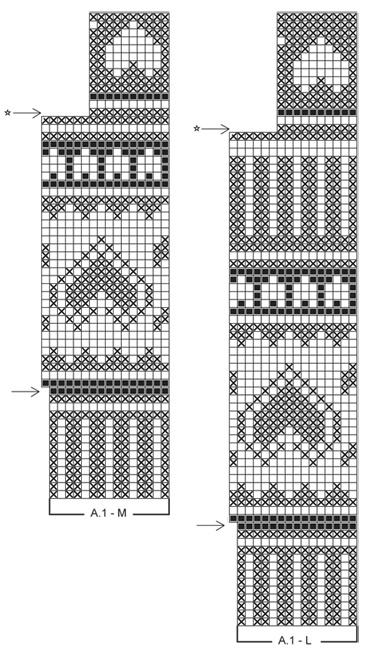
What can you do with our patterns? You can share DROPS patterns online, using the pattern original picture, materials, name and number. But you are NOT ALLOWED to reproduce the complete pattern digitally in any way. Yarn stores are welcome to use the DROPS pattern database to promote the sale of our assortment. You can print out our patterns, make as many copies as you’d like. The only thing we ask is that you don't make any changes / additions to the original printed document. And that the patterns according to the DROPS philosophy are given out to the consumers for free. Editorials that wish to publish our patterns in printed books or magazines can contact us for more information. The sale of garments based on DROPS patterns is permitted as long as they are sold as single items or per order. Further commercial use of the patterns is not permitted. It has to be clearly stated that the garment is made based on a design from DROPS DESIGN. The use of clothing labels of which DROPS DESIGN forms part is conditioned by the inclusion of the following text: “A DROPS DESIGN made by …..”. The use of DROPS photos for marketing purposes/sales is only permitted in connection with the use/sale of DROPS products. The photos may not be cut or edited and the logo should be clearly visible.
We reserve the right to withdraw the permission for use of our patterns at any time, notwithstanding the reason.
Each of our patterns has specific tutorial videos to help you.
These step-by-step tutorials might also help you:
Why is the knitting/crochet tension so important?
Knitting tension is what determines the final measurements of your work, and is usually measured per 10 x 10 cm. It is provided like so: number of stitches in width x number of rows in height - eg: 19 stitches x 26 rows = 10 x 10 cm.
The knitting tension is very individual; some people knit/crochet loosely while others work tightly. You adjust the knitting tension with the needle size, which is why the suggested needle size is only meant as a guide! You need to adjust this (up or down) to ensure that YOUR knitting tension matches the knitting tension provided in the pattern. If you work with a different knitting tension than provided you will have a different yarn consumption, and your work will have different measurements than what the pattern suggests.
The knitting tension also determines which yarns can replace each other. As long as you achieve the same knitting tension you can replace one yarn with another.
See DROPS lesson: How to measure your tension/gauge
See DROPS video: How to make a gauge tension swatch
How do I know how many balls of yarn I need?
The required amount of yarn is provided in grams, eg: 450 g. To calculate how many balls you’ll need you first need to know how many grams are in 1 ball (25g, 50g or 100g). This information is available if you click on the individual yarn quality on our pages. Divide the amount required with the amount of each ball. For example, if each ball is 50g (the most common amount), the calculation will be as follows: 450 / 50 = 9 balls.
Can I use a different yarn than what the pattern suggests?
The important thing when changing from one yarn to another is that the knitting/crochet tension remains the same. This is so that the measurements of the finished piece will be the same as on the sketch provided. It is easier to achieve the same knitting tension using yarns from the same yarn group. It is also possible to work with multiple strands of a thinner yarn to achieve the knitting tension of a thicker one. Please try our yarn converter. We recommend you to always work a test swatch.
Please NOTE: when changing yarn the garment might have a different look and feel to the garment in the photo, due to individual properties and qualities of each yarn.
See DROPS lesson: Can I use a different yarn than the one mentioned in the pattern?
What are the yarn groups?
All our yarns are categorised into yarn groups (from A to F) according to thickness and knitting tension – group A contains the thinnest yarns and group F the thickest. This makes it easier for you to find alternative yarns to our patterns, should you wish to switch yarn. All yarns within the same group have a similar knitting tension and can easily replace each other. However, different yarn qualities have different structures and properties which will give the finished work a unique look and feel.
How do I use the yarn calculator?
At the top of all our patterns you’ll find a link to our yarn calculator, which is a helpful tool should you wish to use a different yarn than suggested. By filling in the yarn quality you wish to replace, the amount (in your size) and number of strands, the calculator will present good alternative yarns with the same knitting tension. Additionally it will tell you how much you’ll require in the new qualities and whether you’ll need to work with multiple strands. Most skeins are 50g (some are 25g or 100g).
If the pattern is worked with multiple colours, every colour will have to be calculated separately. Similarly, if the pattern is worked with several strands of different yarns (for example 1 strand Alpaca and 1 strand Kid-Silk) you will have to find alternatives for each, individually.
Why do you show discontinued yarns in the patterns?
Since different yarns have different qualities and textures we have chosen to keep the original yarn in our patterns. However, you can easily find options among our available qualities by using our yarn calculator, or simply pick a yarn from the same yarn group.
It is possible that some retailers still have discontinued yarns in stock, or that someone has a few skeins at home that they would like to find patterns for.
The yarn calculator will provide both alternative yarn as well as required amount in the new quality.
What size should I knit?
If you think it's hard to decide what size to make, it can be a good idea to measure a garment you own already and like the size of. Then you can pick the size by comparing those measures with the ones available in the pattern's size chart.
You'll find the size chart at the bottom of the pattern.
See DROPS lesson: How to read size chart
Why do I get the wrong knitting tension with the suggested needle size?
The needle size provided in the pattern serves only as a guide, the important thing is to follow the knitting tension. And since knitting tension is very individual, you will have to adjust the needle size to ensure that YOUR tension is the same as in the pattern – maybe you’ll have to adjust 1, or even 2 needle sizes, up or down to achieve the correct tension. For this, we recommend that you work test swatches.
Should you work with a different knitting tension than the one provided, the measurements of the finished garment might deviate from the measurement sketch.
See DROPS lesson: How to measure your tension/gauge
See DROPS video: How to make a tension/gauge swatch
Why is the pattern worked top-down?
Working a garment top-down provides more flexibility and room for personal adjustment. For example it is easier to try the garment on while working, as well as making adjustments to length of yoke and shoulder caps.
The instructions are carefully explaining every step, in the correct order. Diagrams are adjusted to the knitting direction and are worked as usual.
How do I work according to a knitting diagram?
The diagram depicts all rows/rounds, and every stitch seen from the right side. It is read from bottom to top, from right to left. 1 square = 1 stitch.
When working back and forth, every other row is worked from the right side and every other row is worked from the wrong side. When working from the wrong side, the diagram will have to be worked reversed: from left to right, knit stitches are purled, purl stitches are knit etc.
When working in the round every round is worked from the right side and the diagram are worked from right to left on all rounds.
See DROPS lesson: How to read knitting diagrams
How do I work according to a crochet diagram?
The diagram depicts all rows/rounds, and every stitch seen from the right side. It is worked from bottom to top, from right to left.
When working back and forth every other row is worked from the right side: from right to left and every other row is worked from the wrong side: from left to right.
When working in the round, every row in the diagram are worked from the right side, from right to left.
When working a circular diagram you start in the middle and work your way outwards, counter clockwise, row by row.
The rows usually start with a given number of chain stitches (equivalent to the height of the following stitch), this will either be depicted in the diagram or explained in the pattern.
See DROPS lesson: How to read crochet diagrams
How do I work several diagrams simultaneously on the same row/round?
Instructions for working several diagrams after each other on the same row/round, will often be written like so: “work A.1, A.2, A.3 a total of 0-0-2-3-4 times". This means you work A.1 once, then A.2 is worked once, and A.3 is repeated (in width) the number of times provided for your size – in this case like so: S = 0 times, M = 0 times, L=2 times, XL= 3 times and XXL = 4 times.
The diagrams are worked as usual: begin with the first row in A.1, then work the first row in A.2 etc.
See DROPS lesson: How to read knitting diagrams
See DROPS lesson: How to read crochet diagrams
Why are the sleeves shorter in larger sizes?
The total width of the garment (from wrist-to-wrist) will be larger in the larger sizes, despite the actual sleeves being shorter. The larger sizes have longer sleeve caps and wider shoulders, so there will be a good fit in all sizes.
Where on the garment is the length measured?
The measurement sketch/schematic drawing provides information regarding the full length of the garment. If it’s a jumper or a jacket the length is measured from the highest point on the shoulder closest to the neckline, and straight down to the bottom of the garment. It is NOT measured from the tip of shoulder. Similarly, the length of yoke is measured from the highest point on the shoulder and down to where yoke is split into body and sleeves.
On a jacket measures are never taken along bands, unless specifically stated. Always measure inside band stitches when measuring the length.
See DROPS lesson: How to read a schematic drawing
What is a repeat?
Diagrams are often repeated on the round or in height. 1 repeat is the diagram the way it appears in the pattern. If it says to work 5 repeats of A.1 in the round, then you work A.1 a total of 5 times after/next to each other in the round. If it says to work 2 repeats of A.1 vertically/in height you work the entire diagram once, then begin again at the start and work the entire diagram one more time.
Why does the piece start with more chain stitches than it’s worked with?
Chain stitches are slightly narrower than other stitches and to avoid working the cast-on edge too tight, we simply chain more stitches to begin with. The stitch count will be adjusted on the following row to fit the pattern and measurement sketch.
Why increase before the rib edge when the piece is worked top-down?
The rib edge is more elastic and will contract slightly compared to, for example, stocking stitch. By increasing before the rib edge, you avoid a visible difference in width between the rib edge and the rest of the body.
Why increase in the cast-off edge?
It’s very easy to cast off too tightly, and by making yarn overs while casting off (and simultaneously casting these off) you avoid a too tight cast off edge.
See DROPS video: How to bind off with yarn overs (yo)
How do I increase/decrease on every 3rd and 4th row/round alternately?
To achieve an even increase (or decrease) you can increase on, for example: every 3rd and 4th row alternately, like so: work 2 rows and increase on the 3rd row, work 3 rows and increase on the 4th. Repeat this until the increase is complete.
See DROPS lesson: Increase or decrease 1 st on every 3rd and 4th row alternately
How can I work a jacket in the round instead of back and forth?
Should you prefer to work in the round instead of back and forth, you may of course adjust the pattern. You’ll need to add steeks mid-front (usually 5 stitches), and follow the instructions. When you would normally turn and work from the wrong side, simply work across the steek and continue in the round. At the end you’ll cut the piece open, pick up stitches to work bands, and cover the cut edges.
See DROPS video: How to knit steeks and cut open
Can I work a jumper back and forth instead of in the round?
Should you prefer to work back and forth instead of in the round, you may of course adjust the pattern so you work the pieces separately and then assemble them at the end. Divide the stitches for the body in 2, add 1 edge stitch in each side (for sewing) and work the front and back pieces separately.
See DROPS lesson: Can I adapt a pattern for circular needles into straight needles?
Why is the pattern slightly different than what I see in the photo?
Pattern repeats can vary slightly in the different sizes, in order to get the correct proportions. If you’re not working the exact same size as the garment in the photo, yours might deviate slightly. This has been carefully developed and adjusted so that the complete impression of the garment is the same in all sizes.
Make sure to follow instructions and diagrams for your size!
How do I make a women’s size garment into a men’s size one?
If you have found a pattern you like which is available in women’s size it’s not very difficult to convert it to men’s size. The biggest difference will be the length of sleeves and body. Start working on the women size that you think would fit across the chest. The additional length will be worked right before you cast off for the armhole/sleeve cap. If the pattern is worked top-down you can add the length right after the armhole or before the first decrease on sleeve.
Regarding additional yarn amount, this will depend on how much length you add, but it is better with a skein too many than too few.
How do I prevent a hairy garment from shedding?
All yarns will have excess fibres (from production) that might come off as lint or shedding. Brushed yarns (ie hairier yarns) have more of these loose, excess fibres, causing more shedding.
Shedding also depends on what is worn under or over the garment, and whether this pulls at the yarn fibres. It’s therefore not possible to guarantee that there will be no shedding
Below are some tips on how to get the best result when working with hairier yarns:
1. When the garment is finished (before you wash it) shake it vigorously so the looser hairs come off. NOTE: do NOT use a lint roller, brush or any method that pulls at the yarn.
2. Place the garment in a plastic bag and put it in your freezer - the temperature will cause the fibres to become less attached to each other, and excess fibres will come off easier.
3. Leave in the freezer for a few hours before taking it out and shaking it again.
4. Wash the garment according to the instructions on the yarn label.
Why does my garment pill?
Pilling is a natural process that happens to even the most exclusive of fibers. It's a natural sign of wear and tear that is hard to avoid, and that is most visible in high friction areas of your garment like a sweater's arms and cuffs.
You can make your garment look as new by removing the pilling, using a fabric comb or a pill/lint remover.
In the meantime, you can read the questions and answers that others have left to this pattern or join the DROPS Workshop on Facebook to get help from fellow knitters/crocheters!
You might also like...
Valentino |
||||||||||
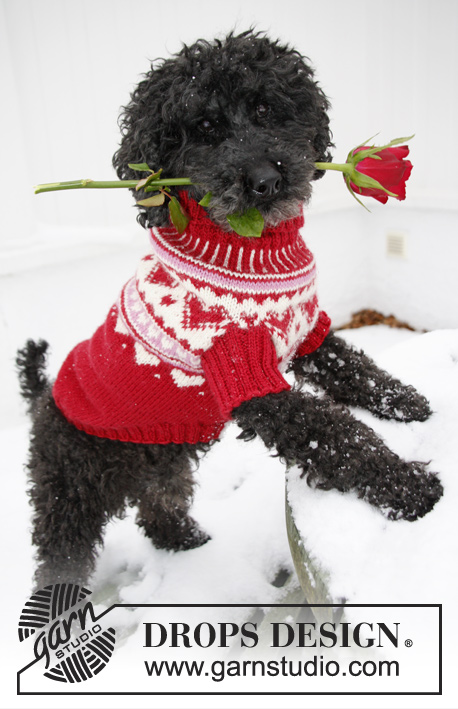 |
 |
|||||||||
Knitted DROPS dog's Christmas jumper for valentine with hearts in ”Karisma”. Size XS - L.
DROPS Extra 0-1010 |
||||||||||
|
PATTERN: See diagram A.1 (choose diagram for correct size). All rows in pattern are worked in stocking st. ADJUSTMENT TIP: If you're knitting for another dog race than given here, note the distance between the dog's front legs (for example a Dachshund has a longer distance between the front legs than a Cocker Spaniel). The distance can be adjusted by slipping more or fewer sts on the stitch holder mid under belly. In addition the circumference on body can be adjusted by adding or subtracting sts (adjust so that sts fit the repetition) and the back can be worked longer or shorter. ---------------------------------------------------------- JUMPER: Worked in the round on double pointed needles/circular needle from the neck down. The smallest size is worked on double pointed needles, the other sizes on circular needle. Cast on 64-92-112-140 sts on double pointed needles/circular needle size 3 mm with wine red. Work rib = K 2/P 2 for 6-8-10-12 cm (= neck). Switch to double pointed needles/circular needle size 3.5 mm – NOW MEASURE PIECE FROM HERE! Work 2 rounds in stocking st while AT THE SAME TIME dec 4-2-7-5 sts evenly on 1st round = 60-90-105-135 sts. READ ALL OF THE FOLLOWING SECTION BEFORE CONTINUING: Then work pattern according to diagram A.1 (choose diagram for correct size) = 4-6-7-9 repetitions on round. AT THE SAME TIME on 1st round marked with arrow in diagram (i.e. 1st round with medium pink) inc 4-6-7-9 sts evenly = 64-96-112-144 sts. When piece measures 4-6-9-12 cm (measured after neck), divide for front legs as follows: Cast off 1 st, work the next 15-15-31-31 sts and then slip them on 1 stitch holder (= under the belly), cast off 1 st, then continue pattern back and forth on needle over the remaining 47-79-79-111 sts (= back piece). AT THE SAME TIME on round marked with arrow and star in diagram (= 1 round with wine red and applies to all sizes except Size XS), adjust no of sts to 47-83-77-107. When piece measures 10-14-18-22 cm (opening for legs measures approx. 6-8-9-10 cm and adjustment of no of sts should now be done in the 3 largest sizes), slip sts on 1 new stitch holder. Slip sts from stitch holder under the belly back on needle (= 15-15-31-31 sts) and work pattern over these sts, the same length as on back piece. Slip all sts on the same needle again and cast on 1 new st in each side between over and under piece = 64-100-110-140 sts. Finish the pattern, then work with wine red until finished measurements. When piece measures 16-20-25-30 cm work next round as follows: Work 2-0-8-6 sts, cast of the next 13-17-17-21 sts (= mid under belly) and work the rest of row. Then work back and forth on needle - AT THE SAME TIME cast off at the beg of every row in each side as follows: 2 sts 1-3-4-6 times, 1 st 9-8-9-8 times, 2 sts 1-3-4-6 times and 3 sts 1 time = 19-37-37-49 sts remain on needle. Piece measures approx. 30-38-47-56 cm incl the neck. ASSEMBLY: Slip the remaining sts on double pointed needles/circular needle size 3 mm, pick in addition up sts with wine red around the cast-off edge so that there are 84-112-144-188 sts in total. Work rib = K 2/P 2 for 2½-3-3-3½ cm, then loosely cast off with K over K and P over P. LEG: Pick up 36-44-52-60 sts on double pointed needles size 3 mm with wine red around one opening for leg. Work rib = K 2/P 2 until leg measures approx. 4-5-6-8 cm, then loosely cast off with K over K and P over P. Repeat around the other opening. NOTE: The neck is folded double when worn. |
||||||||||
Diagram explanations |
||||||||||
|
||||||||||

|
||||||||||

|
||||||||||
|
Have you made this or any other of our designs? Tag your pictures in social media with #dropsdesign so we can see them! Do you need help with this pattern?You'll find tutorial videos, a Comments/Questions area and more by visiting the pattern on garnstudio.com. © 1982-2024 DROPS Design A/S. We reserve all rights. This document, including all its sub-sections, has copyrights. Read more about what you can do with our patterns at the bottom of each pattern on our site. |
||||||||||
With over 40 years in knitting and crochet design, DROPS Design offers one of the most extensive collections of free patterns on the internet - translated to 17 languages. As of today we count 304 catalogues and 11422 patterns - 11422 of which are translated into English (UK/cm).
We work hard to bring you the best knitting and crochet have to offer, inspiration and advice as well as great quality yarns at incredible prices! Would you like to use our patterns for other than personal use? You can read what you are allowed to do in the Copyright text at the bottom of all our patterns. Happy crafting!






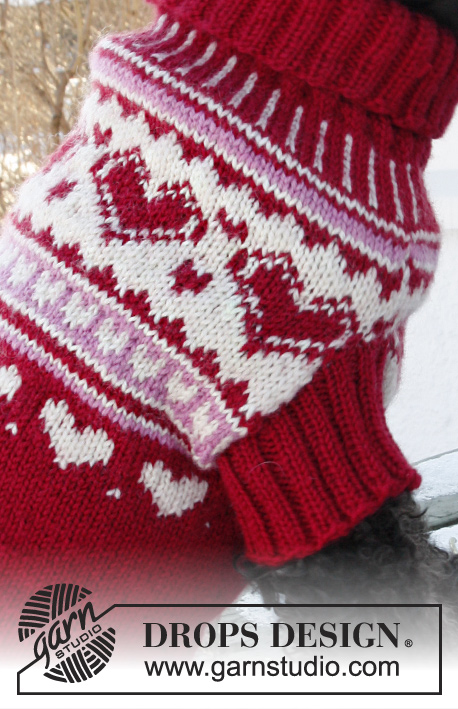


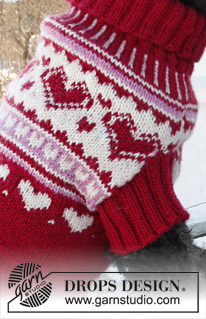

























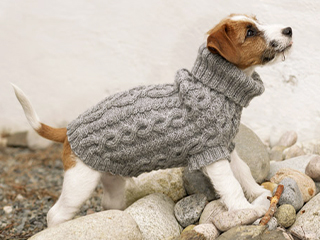












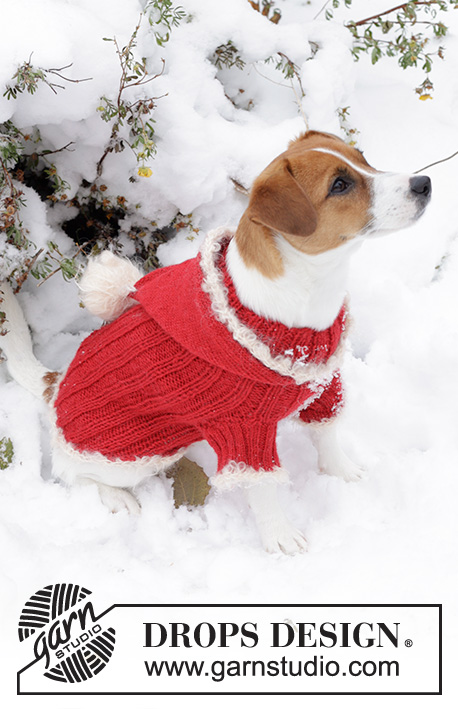






Comments / Questions (64)
Når jeg begynner å strikke mønster frem og tilbake over 79 masker får jeg det ikke til å stemme. Hva gjør jeg feil?
09.12.2021 - 00:35DROPS Design answered:
Hej Harriet, du starter med samme maske (eller masken lige ovenfor) den maske som du sluttede pinden med og strikker tilbage. God fornøjelse!
09.12.2021 - 09:30Pas vraiment. Je fais de cette façon et j'ai bien mes 79 mailles mais le diagramme en a 16m je n'arrive jamais à la fin du diagramme. Ça fait à peu près 6 fois que je défais et réessaye. Ça serait plaisant que maintenant dans vos beaux modèles nous puissions avoir un vidéo pas à pas du début à la fin pour celles qui ne sont pas trop expertes. Merci
11.09.2021 - 17:24DROPS Design answered:
Bonjour Nicole, il vous reste 79 mailles = autrement dit, vous avez rabattu la 1ère m du 1er motif, et la 1ère maille du 3ème motif, il vous reste ainsi sur l'aiguille: les 15 dernières mailles du 3ème motif + 16 mailles des 4ème, 5ème, 6ème et 7ème motif (15 + 4x16 m = 79 m). Lorsque ces mailles sont tricotées, tournez et tricotez en lisant maintenant de gauche à droite (sur l'envers), vous terminerez par l'avant-dernière maille du diagramme. Tournez, commencez (sur l'endroit) par la 2ème maille du diagramme et continuez comme avant. Bon tricot!
13.09.2021 - 08:40Je n'y arrive pas. Vous dites la 1 ère des 31 m qu,on va tricoter sur l'envers mais ces 31 mailles sont sur un arrêt de mailles en attente, je demandais si la m rabattue en premier on la met dans les 31 m en attente avec un total de 31 en attente elle compterait dans les 31 merci
08.09.2021 - 22:09DROPS Design answered:
Bonjour Nicole, la maille rabattue ne fait pas partie des 31 mailles, vos mailles doivent se présenter ainsi à partir du début des tours: 1 maille rabattue (= ouverture patte), 31 mailles en attente (devant/sous le ventre), 1 maille rabattue (= ouverture patte), 79-111 mailles sur l'aiguille (= dos). Cela répond-il à votre question?
09.09.2021 - 08:48Bonjour est-ce que la 1ère maille rabattue doit être mise dans nos 31 mailles transférées sur l'arrêt de mailles où si on compte les 31m après cette première maille rabattue. Si elle ne compte pas dans les 31m est-ce que ça sera notre 1ère maille sur l'envers? merci
03.09.2021 - 18:08DROPS Design answered:
Bonjour Nicole, la 1ère des 31 mailles que l'on va tricoter sur l'envers sera la dernière maille du diagramme tricotée sur l'endroit; Notez dans le diagramme quelle maille vous avez tricoté en dernier sur l'endroit, et au rang suivant sur l'envers, suivez le diagramme de gauche à droite et tricotez cette maille en premier. Bon tricot!
06.09.2021 - 07:10C'est le tournez qui m'embête. Je l'ai fais une fois avec le diagramme lu de gauche à droite. Mais quand je regardais mon tricot ça faisait des bosses et non uni comme le motif sur la ligne 27-28. Quand je finis ma ligne 28 j'ai les fils sur l'aiguille droite. Pouvez-vous me dire de quel côté sont mes fils pour repartir et lire de gauche à droite. Je suis un peu débutante dans le jacquard. Merci
02.09.2021 - 20:47DROPS Design answered:
Bonjour Noemie, lorsque vous divisez votre ouvrage pour l'ouverture des pattes, vous devez tricoter en rangs, et plus en rond, donc alternativement sur l'endroit (comme avant, en rond, en lisant le diagramme de droite à gauche) et sur l'envers (en lisant de gauche à droite). Regardez nos vidéos sur le jacquard en rond: avec le fil dans la main droite ou bien, en fonction de votre façon de tricoter dans la main gauche, elles vous aideront peut être. Bon tricot!
03.09.2021 - 07:19Au 28e rang j'ai rabattu 1m, transféré 31 m., rabattu 1 m. Mis un marqueur à la suiv. Mon diagramme est ok. Mais au 29e rang j'ai sur la broche de gauche sur l'endroit la 1ère m rabattue très loin des autres mailles, et plus loin la 2e m rabattue et la maille marquée du début. Je n'arrive pas à comprendre comment procéder avec ces 2 mailles rabattues? Et ensuite le 29e rang se lira à partir de la gauche?
01.09.2021 - 18:32DROPS Design answered:
Bonjour Noémie, lorsque vous avez rabattu les 2 x 1 m et mis en attente les 31 m, vous tricotez les autres mailles du même rang = le 28ème rang pour vous donc sur les 79-111 mailles restant (après la 2ème maille rabattue), tournez, et tricotez maintenant le 29ème rang sur ces 79-111 mailles, en lisant le digramme de gauche à droite: marquez la dernière maille tricotée sur l'endroit dans le diagramme à la fin du 28è-me rang, c'est la 1ère maille à tricoter sur l'envers. Marquez la dernière maille tricotée sur l'envers dans le diagramme = ce sera la 1ère maille à tricoter sur l'endroit au rang 30 = sur l'endroit. Et continuez ainsi en suivant le diagramme. Bon tricot!
02.09.2021 - 08:18Est-ce qu'on coupe le fil après avoir mis les 31 mailles sur un arrêt? C'est là que j'ai vraiment un problème pour repartir le tricot. Est-ce que la maille rabattue reste seule sur la broche après avoir transféré les 31 mailles. Dans un autre modèle vous dites que ces mailles sur l'arrêt on le tricotera après et la ça dit tricoter 31 mailles c'est ok comme ça? Merci
30.08.2021 - 16:46DROPS Design answered:
Bonjour Noemie, dans ce modèle, vous n'avez pas besoin de couper le fill: rabattez la 1ère m du tour, tricotez les 31 m suivantes et mettez-les en attente, rabattez la m suivante et tricotez les mailles restant sur l'aiguille (79 ou 111 selon la taille). Tournez l'ouvrage et tricotez maintenant sur l'envers en lisant le diagramme de gauche à droite (pensez à bien l'aligner, la dernière maille tricotée sur l'endroit est la 1ère m à tricoter sur l'envers). Continuez ainsi en rang sur ces mailles. Bon tricot!
31.08.2021 - 08:01Je suis rendue au 28e rang du diagramme : J'ai rabattu la première maille avec la couleur écru et j''ai tricoté les 31 m suivantes en suivant le diagramme et après ces 31 mailles je les ai transférées sur un arrêt mailles mais je ne savais plus comment me diriger mes fils de 2 couleurs n\'étaient plus dans le bon sens pour continuer à tricoter. Et est-ce que les 31 premières mailles je continue le jacquard de mon 28e rang. Merci de m\'aider!
29.08.2021 - 19:26À quel moment dans le patron sur l'envers je dois lire le diagramme de la gauche vers la droite. Est-ce rendue aux pattes? Merci très beau modèle!
29.08.2021 - 18:38DROPS Design answered:
Bonjour Noemie, tout à fait, lorsque vous divisez l'ouvrage pour tricoter séparément le dos et la partie entre les pattes, ces 2 pièces vont se tricoter en allers et retours. Notez bien la dernière maille que vous tricotez sur l'endroit pour pouvoir bien repérer dans le diagramme la première maille que vous tricoterez sur l'envers. Bon tricot!
30.08.2021 - 08:03What is the gauge for this pattern?
21.08.2021 - 22:34DROPS Design answered:
Dear Judith, the gaige for this pattern is given where we give the size of the needles to be used. Happy Stitching!
22.08.2021 - 01:04